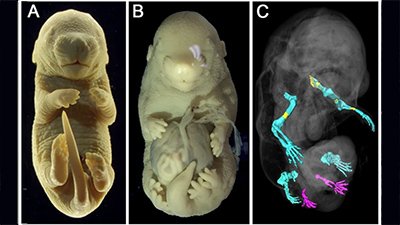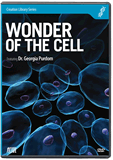Cousin Fly
Hox gene researchers sniff at a common ancestor.
News Source
- Science Daily: “Gene Critical to Sense of Smell in Fruit Fly Identified”
A well-known homeobox (hox) gene in the fruit fly has even more functions than previously known. The essential role this gene and similar genes in vertebrates play in early embryonic development has implications for human neurological and stem cell research, researchers at University of Wisconsin–Madison suggest. They also suggest humans and fruit flies share a common ancestor.
Homeobox genes are master switches that turn whole groups of other genes on and off and thus control many aspects of development. Much of the research on these genes has been done on fruit flies. Many vertebrate homeobox genes have been identified on the basis of similar gene sequences with fruit fly genes. Dr. Grace Boekhoff-Falk’s team studies a fruit fly gene known as distal-less (dll), which has long been known to control limb and peripheral nervous system development. Humans and vertebrate animals have six similar genes called DLX. DLX genes help control brain development, including development of the olfactory system.
Boekhoff-Falk’s team found that dll has even more roles in fruit fly development than previously thought, including controlling olfactory system and central nervous system development. This control, they found, is manifested very early in larval development by controlling the differentiation of stem cells. She hopes the fruitfly model will lead to greater insight into human neurological developmental abnormalities. She also says, “Our model may be useful for further analysis of how this gene regulates stem cells” by revealing “the growth inputs needed to keep the stem-ness of the cells.”
But in addition to helping unravel neurological mysteries and control stem cells, Boekhoff-Falk believes her team’s work challenges a prevailing view among evolutionists.
But in addition to helping unravel neurological mysteries and control stem cells, Boekhoff-Falk believes her team’s work challenges a prevailing view among evolutionists. “The prevailing view is that fly and mammal olfactory systems evolved independently, multiple times over history. But our work challenges that view. We think that when it comes to the olfactory system there may be a common ancestor shared by flies and mammals.” Vertebrates and invertebrates are so very different, evolutionists generally believe the existence of similar systems—such as the ability to smell—evolved convergently. But since her team has found that homologous homeobox genes are involved in the olfactory development of both humans and fruit flies, she says, “This supports the idea that the last common ancestor already had some form of olfactory system and that the overall architecture and key elements of the underlying genetics have been well conserved over time.”
Since the discovery of homeobox genes, evolutionists have pointed to them as a genetic mechanism for evolution of brand new body designs. After all, the reasoning goes, if flipping a genetic switch can change the number of legs a creature has, doesn’t that make it a new creature? Evolution becomes a process of subtracting information to build new kinds of organisms. The gene switches themselves are part of the genetic information making each kind of organism unique. The ultimately insurmountable problem for homeobox-mediated evolution is the origin of that pool of genetic information in the first place.
The Bible asserts that God created all creatures to reproduce after their kinds. This biblical truth is confirmed in science: each organism has genetic information to vary within its kind but is unable to acquire information to evolve into a new kind of organism. Homeobox genes don’t change that. There are genetic similarities among different kinds because our common Designer—God—utilized similar designs to meet various biological and developmental needs. In fact, those design similarities make medical research using animal models—like fruit flies and mice—possible. Similar roles for genes with some sequence similarities do not prove one organism evolved from the other or even that God used one as the raw material for the other. God told us in His eyewitness account that He made all kinds of organisms during Creation Week and created them to reproduce after their kinds.
Further Reading
For More Information: Get Answers
Remember, if you see a news story that might merit some attention, let us know about it! (Note: if the story originates from the Associated Press, FOX News, MSNBC, the New York Times, or another major national media outlet, we will most likely have already heard about it.) And thanks to all of our readers who have submitted great news tips to us. If you didn’t catch all the latest News to Know, why not take a look to see what you’ve missed?
(Please note that links will take you directly to the source. Answers in Genesis is not responsible for content on the websites to which we refer. For more information, please see our Privacy Policy.)
Recommended Resources

Answers in Genesis is an apologetics ministry, dedicated to helping Christians defend their faith and proclaim the good news of Jesus Christ.
- Customer Service 800.778.3390
- © 2024 Answers in Genesis







